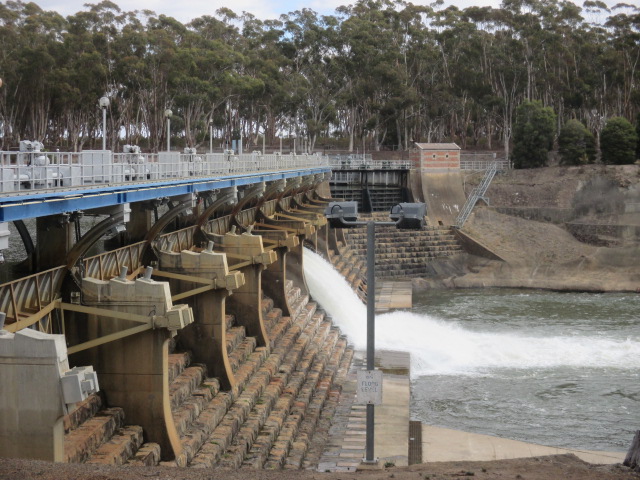Goulburn Weir


Goulburn Weir is located on the Goulburn River, approximately 8 km north of Nagambie. Goulburn Weir raises the level of the Goulburn River so that water can be diverted by gravity along the Stuart Murray Canal, Cattanach Canal and the East Goulburn Main Channel. Diversions to the East Goulburn Main Channel supply the Shepparton Irrigation Area. The weir also forms Lake Nagambie around which recreation, farming and housing developments have grown.
History - The construction of a weir on the Goulburn River began in 1887, and was completed in 1891. The Goulburn Weir was the first major diversion structure built for irrigation in Australia and was considered very advanced for the time. Such was the regard for the structure, it appeared on the reverse of Australian half sovereign and ten shilling banknotes from 1913 until 1933.
Goulburn Weir is a concrete structure founded on bedrock, with its downstream face stepped with granite blocks quarried from the nearby Mt Black.
The metal superstructure of the original weir included 21 cast iron and wrought iron gates mounted between cast iron piers. The gates could be lowered into recesses in the weir crest to pass river and flood flows. Water‑driven turbines provided the power to lower and raise the gates.
The structure also contained one of the first hydro-electric turbines in the southern hemisphere. The electricity was used to illuminate the weir and visitors came from all over Victoria to marvel at the steady bright electric light and floodlit water spray when the gates were operated at night. Goulburn Weir became an important venue for social and recreational events.
Works to stabilise the deteriorating weir structure were completed in 1983, and in 1987 a major refurbishment was undertaken. As part of the works, the main weir superstructure was replaced with nine steel radial gates mounted between concrete piers forming the new structure. Two of the original gates and lifting gear, mounted on the angled western abutment, were retained to preserve part of this unique piece of engineering history.
Review:
The weir is located at the end of Goulburn Weir Road which is a dead-end road. There is a very nice playground, close-up views of the weir, lovely green grassy picnic area with plenty of shaded and unshaded tables and seats, shaded BBQs, toilets and a big playground under shade sails.
There is a basic information centre (open daily 8am - 4pm) with some panels describing the history of the weir.
The weir which was built in 1891 and cost 113,500 pounds to build. On Armistice Day in 1918 flags representing the eight allies flew on the Weir and a large rally was held at the weir to honour the occasion.
New Year's Day Sports Meetings were held regularly during the 1920's and 1930's. Special trains ran from Melbourne to the popular sports days at the Goulburn Weir.
Goulburn Weir was of such national importance that an illustration of the weir featured on the half-sovereign note from 1913 to 1933.
Access to the weir is open for the same hours as the Information Centre.
Photos:
Location
Goulburn Weir Road, Goulburn Weir 3608 Map











